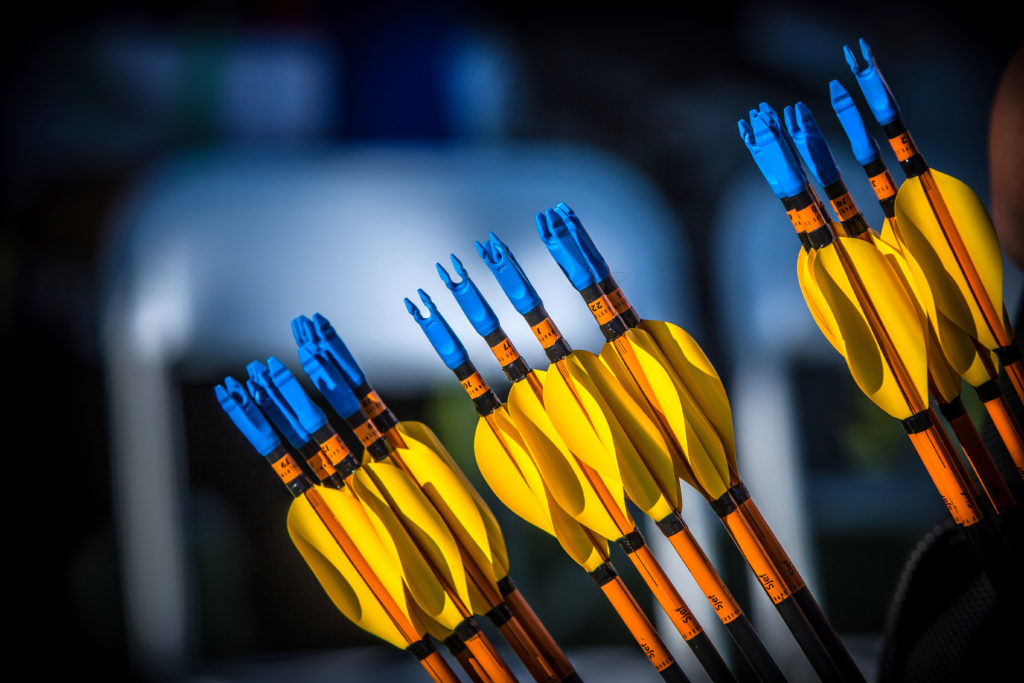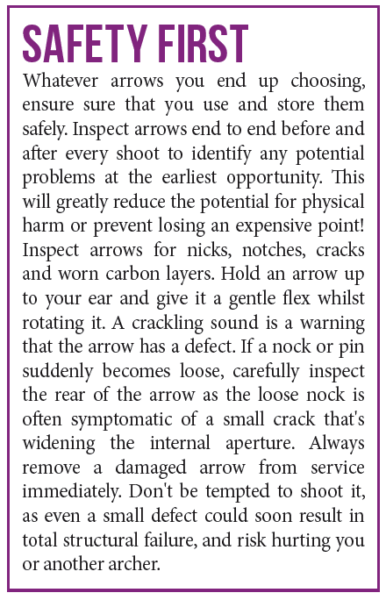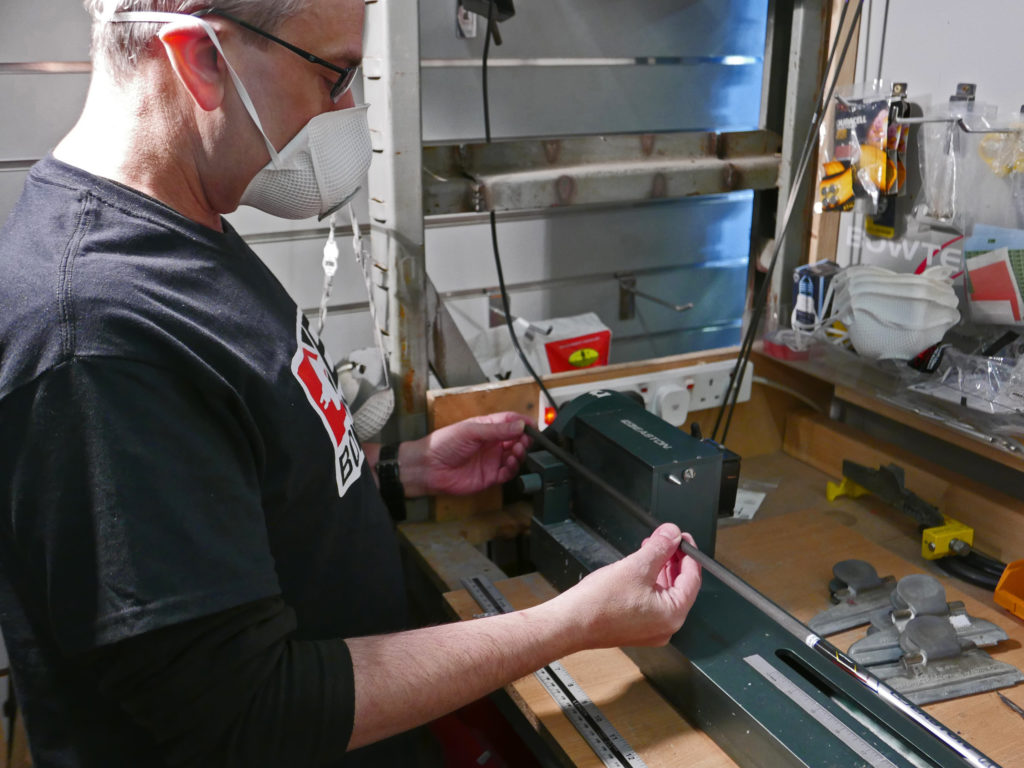Getting arrow selection right first time. With Adrian Tippins.
What standard of arrows do I need?” and “Which should I buy?” are two very frequently asked questions from archers. I spend a lot of time with customers debating these very topics. It’s apparent that archers as consumers want to spend money wisely, yet ultimately they want see a tangible boost in performance.
Performance gains in turn provide both justification and a quick return on a given financial investment. With this in mind, it’s important to select arrows that not only are going to be suitable for a particular point in an archers development, but will also be somewhat future proof and assist in obtaining goals further on down the line.
Balancing all the criteria against budgets is often a difficult task. This is especially true for novices as they are only starting to accrue equipment knowledge whilst trying to navigate the very difficult technical minefield that comes as standard in our sport. Lets now look three different development stages in archery and some associated arrow choices for those categories.
Beginners
When starting out in the sport it’s usual for coaches and retailers to specify aluminium arrows. Here are some good reasons for this choice. Firstly, they are inexpensive and budget is a factor when you have a lot of other items to buy at the outset. Aluminium arrows can be purchased singularly.
This is handy as you can chose to have any number of them and are not tied to having a dozen. As arrow attrition and damage is a certainty, they can easily be replaced individually. Beginners will need to have their first arrows cut overly long. Not only does this create a safety margin on the length, but it also gives room for technique to improve thus allowing an increase in draw length.
Aluminium arrows are also way less sensitive and skittish than their hybrid or full carbon counterparts. This makes them much more forgiving of a poorly tuned bow or a bad release for example. This in turn can yield more satisfactory results and enjoyment at the start.
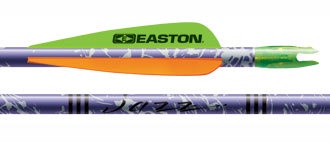
Easton jazz: the standard beginner and have-a-go arrow
The maximum efficient shooting distance of these arrows tends to be quite limited. This is down to the fact they are generally heavy, wide, not aerodynamic and generally coupled with a low poundage bow. I would normally prescribe aluminiums for shooting between 20 to 50 yards.
Aluminium shafts do vary in price, quality and features. I wouldn’t recommend getting the very base models – the middle ground is a much better choice. Not only will you get a stronger arrow via better alloy, they will also utilise a press-fit nock system rather than a glue on taper swage fitting. A damaged nock will be far easier and cleaner to replace and can be done during shooting.
Aluminum arrows tend to use a single weight point that fits the given diameter and wall thickness unless an insert is fitted. In insert will allow the use of screw in points that are available a variety of weights and shapes. There are always times where an exceptions are needed.
Every now & again I’ve come across a beginner who stood out from the crowd and seemed destined for great things. I felt that prescribing aluminium arrows for them would prove to be a false economy. I could easily see them getting up to and beyond 50 yards in a matter of a few months.
Therefore, it would benefit them to have a base model AC hybrid shaft from the start so they wouldn’t have to upgrade and spend the money twice. Arrows that are initially too long can always be cut down; this process can often accommodate an increase in poundage too, should the archer change limbs or adjust the tillers.
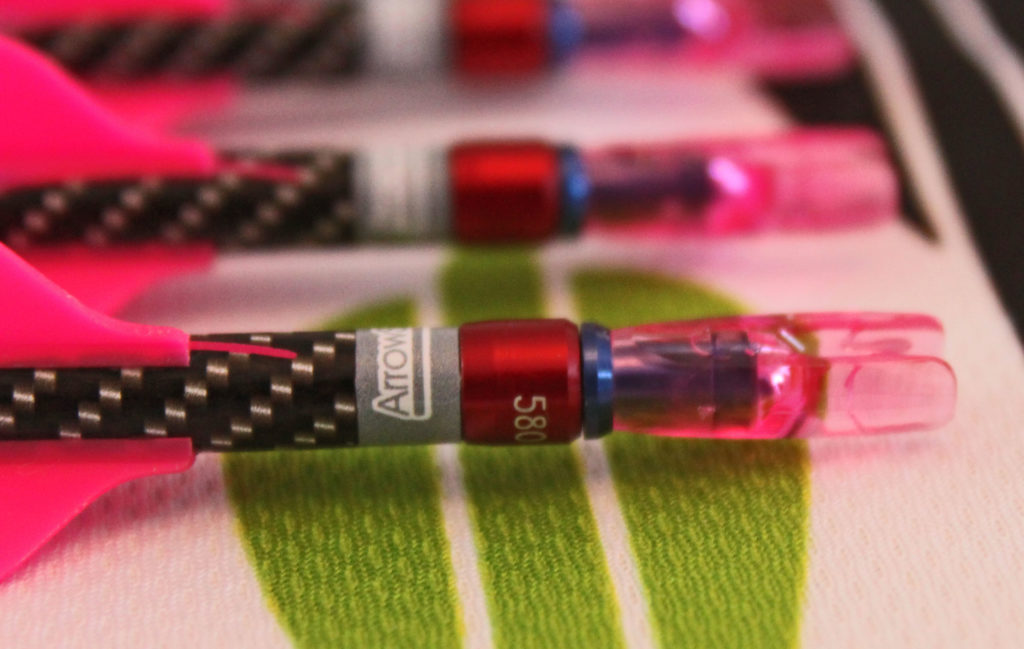
I wouldn’t recommend getting the very base models of aluminium arrows – the middle ground is a much better choice.
Intermediate
The term “intermediate” describes the majority of club archers. They’ve been shooting for a while and have gained one or two classifications. Technique has improved and draw length has settled down to a consistent point. The distances shot are now 50 to 80 yards.
A lot of archers are now seeking higher classifications and possibly starting to think about entering club and local tournaments. This is the time where shooters will experience the biggest performance leap by changing from aluminium to an AC hybrid or full carbon arrow.
For the sake of simplicity, I’ll refer to these two variants as “carbons”. The change to carbons is usually effected in tandem with a change of limbs and/or bow poundage so the new arrow corresponds to the bow’s new peak power output. The shaft diameters are going to be noticeably thinner than the aluminiums and the majority of models will offer the shooter lots of choices for hardware.
Such arrows also allow the fletcher greater options to fully optimise the arrow for that particular archer. Points are now available in variable weights and there’s a choice as to how much point is inside and outside the shaft. These shafts also open up many different nock options including insert, pin, out and pin out models.
Carbons have much lower GPI (grains per inch) figure than metal arrows and subsequently have a much higher arrow speed. Increased aerodynamics and weight saving means that these arrows reach the longer distances far more efficiently and are less affected by adverse weather.
Carbons are very reactive arrows. In essence they go where they are pointed. This is a blessing or a curse depending on how steady and consistent one’s shooting is. Unlike the aluminium carbons are sensitive and the lighter weights means they can be skittish. Shoot badly and errors will be amplified, shoot well and carbons will help elevate you to the next level.
Carbons can be expensive and generally you do get what you pay for. It’s always good to think of them as precision instruments. Generally the higher price means a more precise shaft in terms of weight consistency and straightness tolerance. Deciding how much to spend at this point is tricky for a lot of shooters.
This is because world class arrows are available for an extra cost. Shooters deliberate on whether they can justify the extra outlay and question if they will notice the benefits of the extra tolerances or features. I have a lot of customers who will choose to go to top level just to eliminate seeds of doubt and prevent future upgrades.
Often just knowing they have the best arrows possible allows archers to relax and execute shots with a clear head.
Advanced
Advanced shooters engaged in competitive archery tournaments need top end arrows to shoot 80-100 yards. At advanced level the margins between placing for a medal or not are very fine indeed and every single point counts. Along with super tight tolerances, advanced carbon arrows bring a few new features to the table. Firstly a wider choice of profiles are now available.
Arrows are not only parallel but also barrelled and tapered. The profiles are not only super aerodynamic but also have a pre-determined flex management pattern to suit both compound and recurve shooting. Flex management assists a clean launch and controls arrow flight.
Full carbon arrows do the same thing via Tri-Spine technology. One parallel shaft contains three different spines placed in strategic zones. Elite arrows also sport a choice of point materials. We now see tungsten and A1-Tool steel points along with the regular stainless steel.
These advanced points are not only very durable but also allow the shaft to be cut at a proper AMO length. An arrow with a stainless point would have to be cut 3/4” shorter to accommodate the extra length of the point through the clicker than one fitted with a tungsten point.
This process can stiffen the spine and give tuning issues. A choice of points also allows for the manipulation of the overall balance. With compound bows becoming increasingly more powerful the weight of points has increased to match. It’s now not uncommon for advanced full carbon arrows to have points up to 140 grains or more.
Some full carbon arrows also offer the option to have the rear of the arrows shielded with a metal collar help prevent damage and protect your expensive investment. Advanced arrows are made to the most stringent tolerances and are carefully weighed and batched into dozens at the factory.
These aren’t available singly, so a broken arrow can’t be individually replaced. Precision assembly of these products is essential to be able to reap the benefits of the specification. All arrows in this category should undergo weight matching of components and/or spine location.
It’s only via an assembly procedure like this that they can perform at their full design potential. Before purchasing full carbon arrows always check with your local club and tournament organisers to see if any shared-use venue rules are in force that prohibit the use of full carbon arrows as they can be difficult – or even impossible – to find with a metal detector.
Happy shooting!


